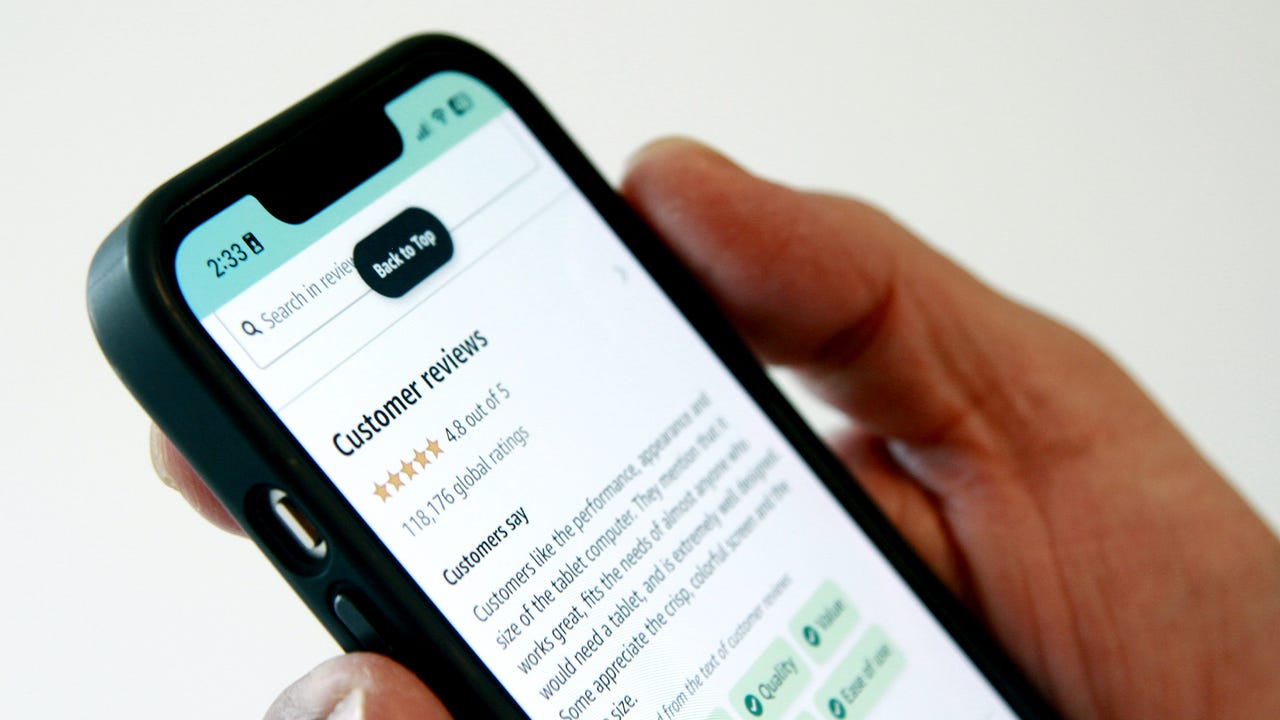Amazon changed how product ratings look, and it's just not helpful

Amazon is constantly updating its e-commerce platform, from testing out AI-generated reviews to growing virtual healthcare services. The latest is a change to how ratings are presented to shoppers browsing products.
Also: Roku is adding over 40 free channels, including local news
Reviews on Amazon are accompanied by a star rating based on a system of five stars, with one being poor and five being excellent. Before the change, searching for a product on Amazon yielded results from different sellers and different options, each with five stars under the product name shaded with yellow to depict the average rating. If a product had an average rating of 4.5 stars, the first four stars and half of the last star would look yellow under the product name, along with the number of reviews to the right.
A look at search results before the update and after.
Amazon changed the ratings to appear as a single yellow star under every product, followed by the percentage of reviewers that gave it five stars in parentheses.
This shifts the focus away from the weighted average rating earned by a product. Amazon calculates its overall ratings using machine learning by processing the different review inputs from customers and taking into account which ones are from verified purchases and how recent the rating or review is.
Also: It's official: Amazon will hold another Prime Day sale in October
Instead of the number of reviews a product has gotten to the right of the five stars, customers now see the percentage of customers that gave it five stars. This means that if an item has 10 reviews and five are five-star ratings while the other five are one-star ratings, you would see "50% 5-star" to the right of the full star instead of just three yellow stars out of five to represent the three-point rating.
Adding the wording "5-star" to the right of the single full star could also be considered misleading, as some shoppers not used to the new system or quickly scanning for a product may not accurately process the information.
Amazon did add the overall number rating to the left of the single yellow star, which some could find more helpful than the more vague shaded-star metric. This means that instead of looking at how many of the five stars are yellow under each product name to figure out its rating without clicking on the product listing, you can now see the overall rating to the left of the lone star -- albeit in tiny print.
Also: These are the top tablets for kids, according to parents
The iPad 9th Gen, for example, has an overall rating of 4.8 stars. Before the update, this looked like five yellow stars, as the 0.2 remaining is a negligible amount of white to color into a roughly 18px-by-18px-sized star. When you search for an iPad after the update, all you see under the 9th Gen iPad is 4.8, a single yellow star, and (87% 50-star).
This example shows the same listing with the old rating format (top) and the new one (bottom).
(Disregard the price differences as the screenshots were taken at different times).
But when it comes to a lower-rated product, like a refurbished first-generation iPad mini with a 3.6-star rating, it gets potentially more confusing. Doing the same search for an iPad, a full star remains below the iPad mini product name, with a 3.6 to the left and a (54% 5-star) to the right. This replaces three full and one-half stars that used to appear before and the number of reviews to the right.
This new look may take time to get used to, but it results in a less user-friendly experience. It makes quickly scanning the products on a search result more difficult, especially if you're like me and seeing the number of reviews, plus the average rating, is what gets you to click on a product to learn more about it and, potentially, buy it.
Also: The best Amazon tech deals: Save big on laptops, headphones, and more
This change comes as the company is caught up in a fight against fraudulent reviews, having announced two new lawsuits against fraudsters this week. These misleading reviews on Amazon are an ongoing concern, as "fake review brokers" use different tactics to deceive customers like writing fabricated reviews without buying or using the product, giving away free products in exchange for positive reviews, and changing product listings after a product has amassed a high rating.
The change isn't available to all customers yet, it appears to be rolling out gradually.
